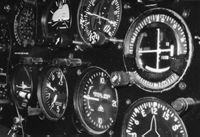 I get the same telephone call several times a week. Customers say that it's time for their pitot-static system/altimeter and transponder certifications. When I get all of their information, it turns out that they don't hold an instrument rating and, therefore, cannot fly that plane legally in IFR conditions. After my explanation, the typical response is, "I thought all aircraft had to have a pitot static/altimeter certification done every twenty-four months, regardless of whether the plane flies in IFR conditions or not." I get the same telephone call several times a week. Customers say that it's time for their pitot-static system/altimeter and transponder certifications. When I get all of their information, it turns out that they don't hold an instrument rating and, therefore, cannot fly that plane legally in IFR conditions. After my explanation, the typical response is, "I thought all aircraft had to have a pitot static/altimeter certification done every twenty-four months, regardless of whether the plane flies in IFR conditions or not."
What exactly is a pitot-static system/altimeter certification? According to FAR 91.411 the static system and altimeter must be tested every two years. The altimeter is put through a series of tests: leak tests, friction tests, scale error, etc.
Next, the technician will check the pitot-static system for any leaks. The pitot-static system gives pressure to pressure-sensitive instruments. The three main instruments that use this system are the altimeter, airspeed indicator and the vertical speed indicator. The pitot part of the system gives impact air pressure and the static part of the system gives surrounding air pressure. The FAR's make it difficult to test pressurized aircraft because each needs to be tested up to its maximum cabin differential pressure. Once it is determined that the pitot-static system and altimeter/encoder comply, the system is certified in accordance with FAR 91.411, and log book entries are issued.
What about the transponder certification? The transponder goes through a series of tests, as well. All the code lines are checked, power out, tolerance's sidelobe suppression, frequency, reply time, etc. The encoder is tested as well, and it is matched to the altimeter. If the transponder does not comply with the FAR, it may need to be aligned. Often, aircraft owners tell us that their transponder worked fine before it failed the certification tests. That is because it is extremely hard to keep some of the old transponders that are still around aligned. ATC might see some information the transponder is producing, but they need to see all of the information.
So, back to the question of what certifications are needed for which aircraft. All aircraft have to have their transponder/encoder checked every two years according to FAR 91.413. If the plane does not fly in airspace requiring a transponder, then the certification is not required. A pitot-static certification is required every two years for aircraft that fly IFR in a controlled airspace. If you do not fly your aircraft IFR, then you do not need a pitot-static/altimeter certification—though it is recommended to have the altimeter checked every so often to make sure it is working properly.
What about cost? It generally takes 3 to 4 hours to perform the altimeter test and check the pitot-static system for leaks. If leaks are detected, it can take several hours to locate them. If the altimeter fails the tests, it means it is time to replace it. An exchanged unit costs around $350 to $550, depending on the service ceiling of the aircraft and the type of altimeter. Encoding altimeters that have the encoder built into the altimeter tend to be more expensive. If the transponder and encoder pass their tests, then you are looking at around one to two hours. If both certifications take minimal time, the average cost should be around $200 to $400, assuming nothing needs to be repaired or replaced.
It is very important to have these certifications when needed. You do not want to get caught with your encoder giving off false readings. The controllers will report your tail number and you will receive a notice in the mail. Not only are the fines expensive, but it can be life-threatening to fly at an altitude different from the one at which other aircraft and ATC read you. |

